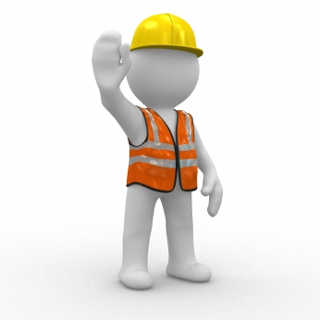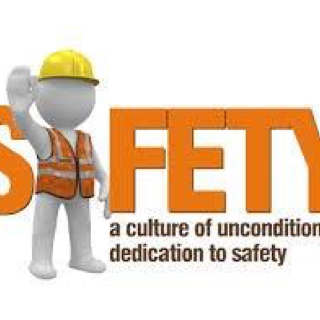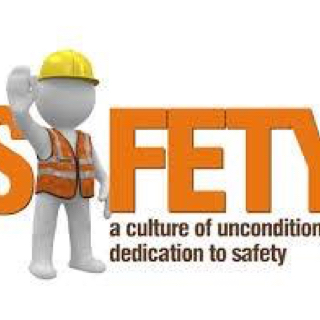Information
-
Document No.
-
BBS Behavior-Based Safety Observation 1. Introduce yourself, ask their name, put the person at ease and explain the process. Ask permission to do an observation. 2. Ask the person to explain the job that is being performed. 3. Ask them to define the hazards and precautions associated with the task they are performing. 4. Ask open-ended questions to learn more about at-risk behaviors. (Ex: What’s the worst accident that can happen? How could you be hurt doing this task? Why are you doing it this way?) 5. Observe the job. 6. Provide positive feedback by praising safe behaviors first. 7. Draw out the corrective action that may be required from the person. 8. Get a personal commitment that the individual will carry out this action and thank the person for participating.
-
Client / Site
-
Conducted on
-
Prepared by
-
Location
-
Personnel
-
Add signature
At-Risk BARRIERs
-
1. Training Issue, Unfamiliar - never trained, unqualified, too long since training, unusual task.
2. Management Pressure / System - time constraints, hurry, priority, poor job coordination.
3. Apathy, Insignificant - don't care, unimportant.
4. Facility and Equipment Condition - design, modification or deterioration contributing to at-risk condition or behavior.
5. Disagreement on At-Risk Practices - cannot agree that an at-risk condition or behavior exists.
6. Personal Factors or Distractions - not thinking, mind not on the task at hand, preoccupied, self imposed pressure.
7. Accepted Culture or Peer Pressure - doing the wrong thing because our peers do, going along with the crowd, rather not “rock the boat”.
8. Environment Related - affected by weather, insects, wildlife.
Critical Behavior Elements
1.0 PPE
-
1.1 • Eye & Face Protection - wearing proper eye and face protection for the task (Safety glasses, face shield, goggles).
-
At-Risk BARRIER
- 0. None
- 1. Training Issue, Unfamiliar
- 2. Management Pressure / System
- 3. Apathy, Insignificant
- 4. Facility & Equipment Condition
- 5. Disagreement on At-Risk Practices
- 6. Personal Factors or Distractions
- 7. Accepted Culture / Peer Pressure
- 8. Environment Related
-
1.2 • Hand Protection - proper gloves (Rubber gloves, Leather Gloves).
-
At-Risk BARRIER
- 0. None
- 1. Training Issue, Unfamiliar
- 2. Management Pressure / System
- 3. Apathy, Insignificant
- 4. Facility & Equipment Condition
- 5. Disagreement on At-Risk Practices
- 6. Personal Factors or Distractions
- 7. Accepted Culture / Peer Pressure
- 8. Environment Related
-
1.3 • Body Protection - proper protective clothing ("Tavel", FR clothing, rubber apron) including seat belts.
-
At-Risk BARRIER
- 0. None
- 1. Training Issue, Unfamiliar
- 2. Management Pressure / System
- 3. Apathy, Insignificant
- 4. Facility & Equipment Condition
- 5. Disagreement on At-Risk Practices
- 6. Personal Factors or Distractions
- 7. Accepted Culture / Peer Pressure
- 8. Environment Related
-
1.4 • Foot Protection - proper foot protection (steel toed safety shoes).
-
At-Risk BARRIER
- 0. None
- 1. Training Issue, Unfamiliar
- 2. Management Pressure / System
- 3. Apathy, Insignificant
- 4. Facility & Equipment Condition
- 5. Disagreement on At-Risk Practices
- 6. Personal Factors or Distractions
- 7. Accepted Culture / Peer Pressure
- 8. Environment Related
-
1.5 • Fall Protection - properly protected from falling when working where this hazard exits (safety harness, body harness, tie-offs).
-
At-Risk BARRIER
-
1.6 • Hearing Protection - wearing proper hearing protection where the hazard exists (ear plugs, ear muffs).
-
At-Risk BARRIER
-
1.7 • Head Protection - bump cap worn appropriately where hazard exists.
-
At-Risk BARRIER
- 0. None
- 1. Training Issue, Unfamiliar
- 2. Management Pressure / System
- 3. Apathy, Insignificant
- 4. Facility & Equipment Condition
- 5. Disagreement on At-Risk Practices
- 6. Personal Factors or Distractions
- 7. Accepted Culture / Peer Pressure
- 8. Environment Related
2.0 BODY USE and POSITION
-
2.1 • Line of Fire - worker is positioning his body to avoid injury by any moving hazards (escaping steam, falling objects).
-
At-Risk BARRIER
- 0. None
- 1. Training Issue, Unfamiliar
- 2. Management Pressure / System
- 3. Apathy, Insignificant
- 4. Facility & Equipment Condition
- 5. Disagreement on At-Risk Practices
- 6. Personal Factors or Distractions
- 7. Accepted Culture / Peer Pressure
- 8. Environment Related
-
2.2 • Lifting - proper lifting techniques (using legs, back straight, weight close to body, feet flat on floor, knees bent).
-
At-Risk BARRIER
- 0. None
- 1. Training Issue, Unfamiliar
- 2. Management Pressure / System
- 3. Apathy, Insignificant
- 4. Facility & Equipment Condition
- 5. Disagreement on At-Risk Practices
- 6. Personal Factors or Distractions
- 7. Accepted Culture / Peer Pressure
- 8. Environment Related
-
2.3 • Pinch Point - aware of and avoid pinch points (pinch points blocked, maintaining body parts out of pinch points).
-
At-Risk BARRIER
- 0. None
- 1. Training Issue, Unfamiliar
- 2. Management Pressure / System
- 3. Apathy, Insignificant
- 4. Facility & Equipment Condition
- 5. Disagreement on At-Risk Practices
- 6. Personal Factors or Distractions
- 7. Accepted Culture / Peer Pressure
- 8. Environment Related
-
2.4 • Awkward Position - proper body mechanics (over-extended, using legs not back when pulling).
-
At-Risk BARRIER
- 0. None
- 1. Training Issue, Unfamiliar
- 2. Management Pressure / System
- 3. Apathy, Insignificant
- 4. Facility & Equipment Condition
- 5. Disagreement on At-Risk Practices
- 6. Personal Factors or Distractions
- 7. Accepted Culture / Peer Pressure
- 8. Environment Related
3.0 TOOLS and EQUIPMENT
-
3.1 • Tool Use / Selection - using the right tool for the job and using it properly (correct style wrench).
-
At-Risk BARRIER
- 0. None
- 1. Training Issue, Unfamiliar
- 2. Management Pressure / System
- 3. Apathy, Insignificant
- 4. Facility & Equipment Condition
- 5. Disagreement on At-Risk Practices
- 6. Personal Factors or Distractions
- 7. Accepted Culture / Peer Pressure
- 8. Environment Related
-
3.2 • Condition - tools, even if correct for the job, must be in good condition (electrical cords properly insulated).
-
At-Risk BARRIER
- 0. None
- 1. Training Issue, Unfamiliar
- 2. Management Pressure / System
- 3. Apathy, Insignificant
- 4. Facility & Equipment Condition
- 5. Disagreement on At-Risk Practices
- 6. Personal Factors or Distractions
- 7. Accepted Culture / Peer Pressure
- 8. Environment Related
-
3.3 • Position Parked - vehicle is left in the position which creates the least possibility of incident (parking break set, engine off, forks down)
-
At-Risk BARRIER
- 0. None
- 1. Training Issue, Unfamiliar
- 2. Management Pressure / System
- 3. Apathy, Insignificant
- 4. Facility & Equipment Condition
- 5. Disagreement on At-Risk Practices
- 6. Personal Factors or Distractions
- 7. Accepted Culture / Peer Pressure
- 8. Environment Related
-
3.4 • Ergonomics (Design) - system / component designed to be user friendly, with the operator(s) in mind (accessible, low strain).
-
At-Risk BARRIER
- 0. None
- 1. Training Issue, Unfamiliar
- 2. Management Pressure / System
- 3. Apathy, Insignificant
- 4. Facility & Equipment Condition
- 5. Disagreement on At-Risk Practices
- 6. Personal Factors or Distractions
- 7. Accepted Culture / Peer Pressure
- 8. Environment Related
4.0 EYES ON PATH / HANDS
-
4.1 • Eyes On Path - watching what you're doing and where you're going (looking for / being aware of hazards).
-
At-Risk BARRIER
- 0. None
- 1. Training Issue, Unfamiliar
- 2. Management Pressure / System
- 3. Apathy, Insignificant
- 4. Facility & Equipment Condition
- 5. Disagreement on At-Risk Practices
- 6. Personal Factors or Distractions
- 7. Accepted Culture / Peer Pressure
- 8. Environment Related
-
4.2 • Eyes On Hands - aware of hand placement (watching where hands are placed during work or near hazard, not being distracted).
-
At-Risk BARRIER
- 0. None
- 1. Training Issue, Unfamiliar
- 2. Management Pressure / System
- 3. Apathy, Insignificant
- 4. Facility & Equipment Condition
- 5. Disagreement on At-Risk Practices
- 6. Personal Factors or Distractions
- 7. Accepted Culture / Peer Pressure
- 8. Environment Related
-
4.3 • Ascending / Descending - proper climbing techniques on ladders/stairs, both portable and stationary (facing ladder, not skipping rungs or steps, hold onto railing).
-
At-Risk BARRIER
- 0. None
- 1. Training Issue, Unfamiliar
- 2. Management Pressure / System
- 3. Apathy, Insignificant
- 4. Facility & Equipment Condition
- 5. Disagreement on At-Risk Practices
- 6. Personal Factors or Distractions
- 7. Accepted Culture / Peer Pressure
- 8. Environment Related
-
4.4 • Travel Path - non-hazardous route of travel, path of least potential incident (walking / driving around spills, barricades, rough terrain).
-
At-Risk BARRIER
- 0. None
- 1. Training Issue, Unfamiliar
- 2. Management Pressure / System
- 3. Apathy, Insignificant
- 4. Facility & Equipment Condition
- 5. Disagreement on At-Risk Practices
- 6. Personal Factors or Distractions
- 7. Accepted Culture / Peer Pressure
- 8. Environment Related
-
4.5 • Travel Speed - rate of speed to minimize potential incidents based on environment, surroundings or changing conditions.
-
At-Risk BARRIER
- 0. None
- 1. Training Issue, Unfamiliar
- 2. Management Pressure / System
- 3. Apathy, Insignificant
- 4. Facility & Equipment Condition
- 5. Disagreement on At-Risk Practices
- 6. Personal Factors or Distractions
- 7. Accepted Culture / Peer Pressure
- 8. Environment Related
5.0 PROCESS HAZARDS
-
5.1 • LOTO - are workers protected from potential hazards (locks / tags / grounds applied or removed, lines depressurized).
-
At-Risk BARRIER
- 0. None
- 1. Training Issue, Unfamiliar
- 2. Management Pressure / System
- 3. Apathy, Insignificant
- 4. Facility & Equipment Condition
- 5. Disagreement on At-Risk Practices
- 6. Personal Factors or Distractions
- 7. Accepted Culture / Peer Pressure
- 8. Environment Related














